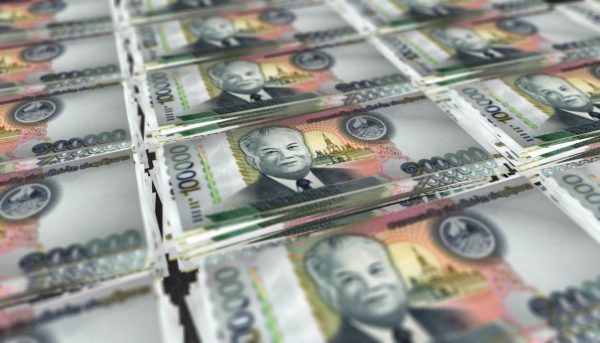Over the last several weeks, the economic situation in Laos has begun to worsen. Fuel shortages have been widely reported as a plummeting currency is driving up the cost of imports. The Lao kip was trading at around 9,400 to the dollar back in September 2021, but fell to 13,450 last week. The central bank announced measures to combat the squeeze, seemingly pinning the blame on currency manipulators and speculators. There is probably some of that going on, but there are also deeper structural issues at play here.
The first is that the U.S. Federal Reserve is raising interest rates, causing the dollar to increase in value relative to most currencies. This happens whenever the Fed raises interest rates, and it often causes capital to flow out of emerging markets, especially those that are running large fiscal or current account deficits. To hedge against this, emerging market central banks generally stockpile large foreign exchange reserves which can be used to backstop the currency during times of high volatility. Doing so sends a message to global creditors that the country in question can cover its debts.
There have been doubts for some time that Laos is capable of covering its debts. The country imported $6.36 billion worth of goods in 2021, and has also been accumulating significant liabilities on its balance of payments, all of which increases vulnerability to capital flight. Investors appear to believe that the central bank’s foreign exchange reserves, which stood at $1.26 billion in December 2021, are insufficient.
Added to that is the double shock of high commodity prices, which have driven the price of fuel imports way up. That is hardly unique to Laos. Every country in the world is struggling with the same issue and for short-term liquidity crunches such as these there are tools available to smooth things out until fuel prices stabilize. It is obviously creating economic hardship in the short-term, but eventually the price of fuel will come down.
The bigger issue over the long-term is whether Laos has incurred too many liabilities on its balance of payments relative to the increase in productive capacity these liabilities are likely to generate. Investment inflows into Laos have accelerated dramatically in recent years. Net foreign direct investment increased from $635 million in 2012 to $1.7 billion in 2017. The rate of investment cooled in recent years, but in 2021 net inflows were still over $1 billion.
Foreign investment is a bit of a double-edged sword, as these inflows have to be repaid over time to the owners of the capital through dividends and interest payments. Consequently, as FDI inflows have increased so have capital outflows in the primary income account as investors are paid back. These gross outflows totaled $1.23 billion in 2021.
The million (billion?) dollar question is: What are the investment inflows being used for? If they are increasing productive capacity in excess of the cost of the capital, they are a net gain to the economy. If the cost of the capital exceeds the economic benefit, they are a drag on the economy and will eventually burn a hole in the country’s balance of payments.
Capital markets seem to think the latter is the more likely scenario, and as a result the kip has seen a significant loss of value in recent months. High commodity prices and interest rate hikes in the U.S. has accelerated this process, but it was likely going to happen anyway given investor sentiment and low levels of foreign exchange reserves.
Laos, a nation with a population of just 7 million, has a limited domestic market, so much of this foreign investment has been aimed at infrastructure that can boost exports like electricity generation and transportation. Laos has dramatically increased its electricity exports, almost all of which are absorbed by Thailand. According to OEC data, in 2010 Laos exported $272 million worth of electricity to Thailand. In 2020, such exports ballooned to $1.9 billion, accounting for 31 percent of all exports. Almost all of this was purchased by Thailand. But is it enough?
For this model to work, Laos has to convert foreign investment into exports. It needs to sell electricity from foreign-funded power plants to Thailand, and it needs its expensive new high-speed rail line to increase the volume of goods and services it exports to China. It’s hard to say what will happen in the long-run; 10 years from now exports could be booming, and it will turn out these investments were worth the risk.
But at the moment it makes the economy heavily dependent on just two of its neighbors, Thailand and China, to absorb exports. And meanwhile the accumulated liabilities from all of these foreign investments and lack of deep foreign exchange reserves have made Laos particularly sensitive to shocks in the global financial system, which is why they have been one of the first countries in the region to really struggle with capital flight.


